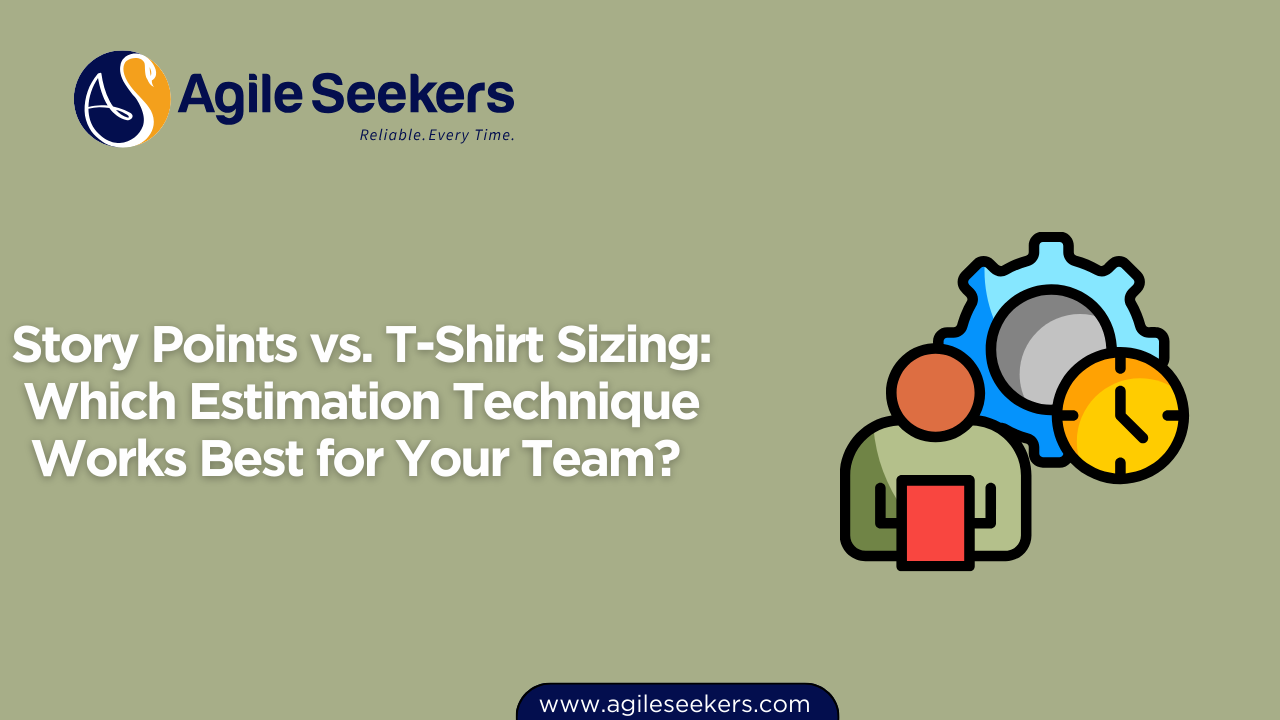Story Points vs. T-Shirt Sizing: Which Estimation Technique Works Best for Your Team?

Accurate estimation is a critical part of Agile planning. It helps teams set realistic expectations, plan iterations, and commit with confidence. Two of the most common estimation techniques in Agile are Story Points and T-Shirt Sizing. While both aim to gauge effort or complexity, they work in different ways and suit different team dynamics.
So, how do you decide which one is right for your team?
Let’s break down each technique, compare their strengths, and explore practical considerations to help you make an informed choice.
What Are Story Points?
Story Points represent a relative measure of effort required to complete a user story. Instead of estimating in hours or days, teams assign a number that reflects the complexity, risk, and effort compared to other stories.
Common scales include:
-
Fibonacci sequence: 1, 2, 3, 5, 8, 13, etc.
-
Modified scales: 0.5, 1, 2, 4, 8, etc.
These values encourage teams to focus on comparisons, not precision.
Benefits of Using Story Points
-
Encourages team-based discussion and shared understanding.
-
Accounts for uncertainty and complexity.
-
Helps build velocity over time for predictable forecasting.
-
Reduces estimation debates over "how many hours this task will take."
Limitations of Story Points
-
New teams might struggle to grasp what each number means.
-
Velocity can vary between teams, making comparisons difficult.
-
Without calibration, numbers can lose meaning quickly.
For teams going through Certified Scrum Master training, Story Points are often a core part of the learning process due to their alignment with Agile planning and iteration goals.
What Is T-Shirt Sizing?
T-Shirt Sizing is a high-level relative estimation method using categories like:
-
XS
-
S
-
M
-
L
-
XL
Instead of numbers, these sizes give a qualitative sense of effort or complexity. It’s commonly used early in product discovery or backlog grooming, especially when information is incomplete.
Benefits of T-Shirt Sizing
-
Simple and intuitive — easy for new teams.
-
Useful for high-level roadmap planning.
-
Removes the pressure of numerical precision.
-
Helps stakeholders understand estimates at a glance.
Limitations of T-Shirt Sizing
-
Lack of granularity for sprint planning.
-
Mapping sizes to actual capacity is inconsistent.
-
Doesn’t provide enough data to calculate team velocity.
-
Risk of subjective interpretation between team members.
While it’s less common in formal CSM certification training, T-Shirt Sizing can be a good precursor to more detailed estimation techniques.
Comparing Story Points vs. T-Shirt Sizing
To understand which technique fits better, consider the table below:
| Criteria | Story Points | T-Shirt Sizing |
|---|---|---|
| Estimation Format | Numerical (e.g., 1, 3, 5) | Qualitative (e.g., S, M, L) |
| Use Case | Iteration planning, velocity tracking | Initial sizing, roadmap planning |
| Ease of Use | Requires calibration and practice | Intuitive for most team members |
| Precision | High (supports granular planning) | Low (good for rough estimates) |
| Velocity Tracking | Yes | No |
When Should You Use Story Points?
Story Points work best when:
-
You have a mature Agile team with a few sprints under their belt.
-
Velocity tracking and forecasting are important to your process.
-
Your team uses Scrum or Kanban and commits to sprint goals.
-
You want to capture complexity and uncertainty in estimates.
Story Points align well with certified scrum master training, where planning and iteration control are core concepts.
When Should You Use T-Shirt Sizing?
Use T-Shirt Sizing when:
-
You're in early discovery or backlog refinement.
-
Team members are new or not yet familiar with Agile estimation.
-
You need a quick, high-level estimate to inform roadmaps.
-
Stakeholders want simple estimates for comparison.
This technique is also helpful when conducting Agile estimations with cross-functional or non-technical stakeholders, where numeric values might create confusion or misinterpretation.
Can You Use Both Techniques Together?
Yes. In fact, many Agile teams do.
A common approach:
-
Start with T-Shirt Sizing during product backlog refinement.
-
Break down into Story Points during sprint planning sessions.
This hybrid method balances simplicity and precision. It also allows teams to engage stakeholders early without losing estimation accuracy when committing to a sprint.
Teams undergoing CSM training often learn to apply multiple estimation strategies and adapt based on the project stage or audience.
Common Pitfalls to Avoid
Whether you choose Story Points or T-Shirt Sizing, be cautious of the following:
-
Converting estimates to hours: This defeats the purpose of abstract estimation.
-
Inconsistent interpretation: Without team consensus, estimates lose value.
-
Anchoring to previous values: Don’t let one estimate bias the next.
-
Overcomplicating estimation: Keep it simple and collaborative.
For teams refining their Agile practice, especially those pursuing CSM certification, awareness of these pitfalls is crucial to building sustainable estimation habits.
Wrapping Up: Choosing the Right Estimation Approach
There's no universal answer to which technique is "better." It depends on your team’s context, experience, and goals.
-
Start with T-Shirt Sizing if you're early in product discovery or introducing Agile.
-
Shift to Story Points as your team matures and needs reliable forecasting.
-
Combine both if you're working across multiple stakeholders and want to streamline planning without sacrificing depth.
Ultimately, estimation is a team activity. Choose the method that promotes conversation, builds alignment, and supports continuous improvement.
If you're looking to strengthen your Agile practices, explore our CSM certification training to learn estimation techniques, planning strategies, and facilitation skills that empower Scrum teams to thrive.
Also read - How to Facilitate Powerful Retrospectives with Data and Actionable Outcomes
Also see - Definition of Ready vs. Definition of Done




















